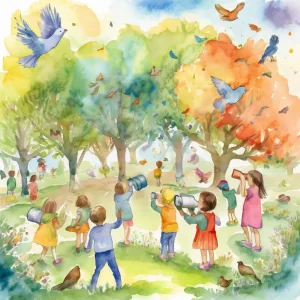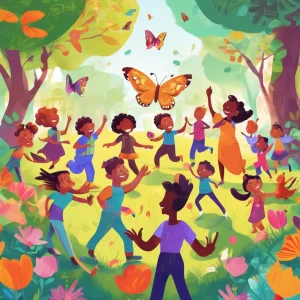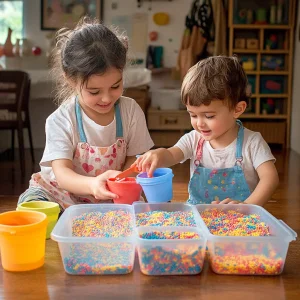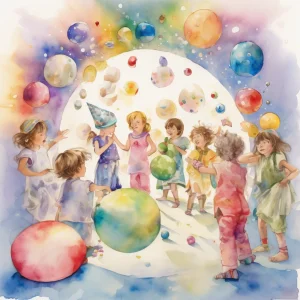Activity
Similar Activities
Nature Shapes Adventure: Bird Watch & Scavenger Hunt
Children’s Age: 4–5 years
Activity Duration: 10 minutes
An outdoor activity for children aged 4-5 years combining bird watching and shape recognition.
Activity Duration: 10 minutes
Sensory Sound Box Exploration: A Musical Adventure
Children’s Age: 1–1.5 years
Activity Duration: 5 – 20 minutes
An engaging activity involving sensory exploration of sound using a variety of household items.
Activity Duration: 5 – 20 minutes
Enchanted Melodies: The Musical Tunnel Crawl
Children’s Age: 1–1.5 years
Activity Duration: 5 minutes
An engaging tunnel crawling activity with musical instruments for children aged 13-17 months.
Activity Duration: 5 minutes
Enchanted Sound Symphony: Sensory Sound Walk
Children’s Age: 2 months – 3 years
Activity Duration: 5 – 25 minutes
Exploring sounds and textures through a sensory walk outdoors.
Activity Duration: 5 – 25 minutes
Adventure of Rhyme and Move Outdoor Magic
Children’s Age: 3–4 years
Activity Duration: 10 – 25 minutes
"Rhyme and Move Outdoor Adventure" is a fun activity that combines nature-themed rhymes with movement in an outdoor setting. Children get to explore the outdoors, practice language…
Activity Duration: 10 – 25 minutes
Rainbow Rice Sensory Play Adventure
Children’s Age: 1.5–2 years
Activity Duration: 10 minutes
Engage toddlers aged 18 to 24 months in a sensory play activity using colored rice to enhance physical, social-emotional, and sensory development. Gather materials like uncooked wh…
Activity Duration: 10 minutes
Whispers of the Forest: Sensory Nature Walk
Children’s Age: 0 – 6 months
Activity Duration: 5 – 10 minutes
The Sensory Nature Walk activity is tailored for infants aged 0 to 6 months, offering a safe and engaging outdoor experience. Bring essentials like a baby carrier, sunscreen, and a…
Activity Duration: 5 – 10 minutes
Sensory Scarf Play Activity: Colors in Motion
Children’s Age: 3 – 9 months
Activity Duration: 5 minutes
The sensory scarf play activity is ideal for children aged 3 to 9 months, supporting physical development and communication skills. Set up a safe play area with soft, colorful scar…
Activity Duration: 5 minutes
Enchanted Forest: Sensory Nature Walk Adventure
Children’s Age: 3 – 9 months
Activity Duration: 5 – 10 minutes
Engage infants aged 3 to 9 months in a sensory exploration experience with the Sensory Nature Walk activity. Stimulate physical development by letting infants touch natural items, …
Activity Duration: 5 – 10 minutes
Sensory Nature Walk: A Baby's Adventure Outdoors
Children’s Age: 0 – 6 months
Activity Duration: 10 minutes
Engage infants aged 0 to 6 months in sensory exploration with the Sensory Nature Walk activity. Gather essentials like a baby carrier, sunscreen, and soft toys for a safe outdoor e…
Activity Duration: 10 minutes
Holiday Magic: Baby Sensory Play Wonderland
Children’s Age: 1 – 3 months
Activity Duration: 5 – 10 minutes
Engage your 0 to 3-month-old baby in a soothing holiday sensory play experience to aid their physical development. Gather soft holiday fabric, small toys, and maybe some festive mu…
Activity Duration: 5 – 10 minutes
Imaginary Adventures: Mini Bowling Feelings Story Game
Children’s Age: 2–5 years
Activity Duration: 10 minutes
An engaging activity promoting sensory development, creativity, reading, and storytelling.
Activity Duration: 10 minutes


























